Mazarrón
Mazarrón is a municipality in the autonomous community and province of Murcia, southeastern Spain. The municipality has an area of 318.7 square kilometres (123.1 sq mi),[2] and a population of 31,562 inhabitants in 2019.[3] A military fort (named C1 or Castillitos-small castles) built between 1930 and 1936 during the reign of Alfonso XIII of Spain and the Second Spanish Republic exists as a tourist attraction on the old road between Mazarrón and Cartagena, and although it is accessible from the Bay of Mazarrón it is not in the municipality itself.
Mazarrón | |
|---|---|
Municipality | |
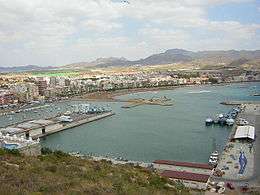 Mazarrón port and beach | |
 Flag 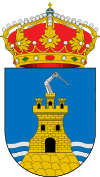 Coat of arms | |
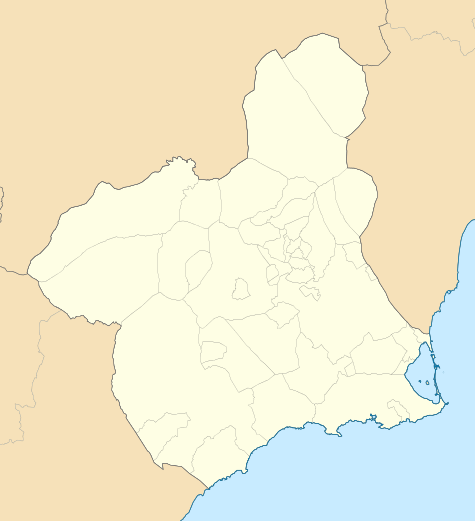 Mazarrón Location in Region of Murcia  Mazarrón Mazarrón (Spain) | |
| Coordinates: 37°35′54″N 1°18′50″W | |
| Country | |
| Autonomous Community | |
| Province | Region of Murcia |
| Comarca | Bajo Guadalentín |
| Government | |
| • Mayor | Ginés Campillo Méndez (UIDM) |
| Area | |
| • Total | 319 km2 (123 sq mi) |
| Elevation (AMSL) | 55 m (180 ft) |
| Population (2018)[1] | |
| • Total | 31,562 |
| • Density | 99/km2 (260/sq mi) |
| Time zone | UTC+1 (CET) |
| • Summer (DST) | UTC+2 (CEST (GMT +2)) |
| Postal code | 30870 |
| Area code(s) | +34 (Spain) + 968 (Murcia) |
| Website | www |
The Bay of Mazarrón is sheltered by the last foothills of the Sierra de la Almenara, a mining area since the Carthaginian era. Over 35 km of beaches, unspoiled coves and rocky sea beds. Due to the nature of the surrounding rocks, however, the beach at Bolnuevo is of coarse grit, as are most of the beaches along this part of the coast.
The Torre de los Caballos on Los Caballos peak were built for the town's protection against pirates from the mid-16th to the early 18th centuries.[4]
The economic development of the early 20th century led to the construction of emblematic buildings in the style known as Murcian Modernism, including the Mazarrón Town Hall and the former Cultural Athenaeum.
The guns in Cartagena were built to defend the vital port of Cartagena in the 20th century, these guns alongside the fort and other coastal defences, stand 56 feet long, weighing a total of 88 tons each and being able to fire at a range of some 20 miles.
Geography
Physical geography
Mazarrón is located in the South of Region of Murcia. This municipality borders Cartagena and Fuente Álamo at its east, Alhama de Murcia and Totana and its North and Lorca at its West. In addition, it adjoins the Mediterranean Sea at its south.[2]
The main landform of the municipality is a mountain range named Sierra de Las Moreras, which is located in the west.[5][6] In regards to waterbeds, there is not any river, but there are several arroyos (creeks) or ramblas and a remarkable one is Rambla de Las Moreras.[7] There is also a group of three ponds named Lagunas de Las Moreras.[8][9]
Human geography
This municipality has 13 towns and villages. These are Mazarrón which is placed in the southern half and is inhabited by 12,478 people; Puerto de Mazarrón, that is located in the south and is home to 10,253 people; Saladillo, that is placed in the northern half and has a population of 3,086; Ifre-Cañada de Gallego, that is located in the southeast and is occupied by 1,194 people; Balsicas, that is placed in the east and is home to 1,174 people; Moreras, that is located in the south half and is inhabited by 1,034 people; Garrobo, that is placed in the northern half and has a population of 475; Leiva, that is located in the southwestern quarter and is home to 306 people; Majada, which placed in the east and is inhabited by 200 people; Ifre-Pastrana, which is located in the southwest and is inhabited by 456 people; Gañuelas, which is placed in the northwest and has a population of 75; Rincones, that is located in the eastern half and is home to 27 people and Mingrano, which is placed in the east and is occupied by 23 residents.[10][11]
History
Prehistory
The most ancient data which are known about the territory corresponding to the current municipality date from the Middle and Upper Paleolithic. There are some archaeological sites such one which is placed in Permera Cave, other which is located in Los Tollos ravine, one which is named La Peñica and another one whose name is Las Palomas. The two last ones are placed in the hillock Cabezo del Faro.[12]
The remains of these spots consist of material related to manufactured tools such as flint spear tips, scrapers, racloirs and hammerstones. There were also another ones related to ritual burials. As glaciations ended, prehistory communities organizations were developing.[12]
When the sedentism appeared, some material such as ceramic and some structures such as the first megalithic burial sites in Palomarico Cave and Caballo Cave emerged.
In regards to Chalcolithic and Bronze Age in this current municipality, a prehistoric hamlet in a local range named Sierra de las Moreras can be mentioned. A cemetery is located in this ancient locality, but nowadays the only remains of this necropolis consist of a circle-shaped megalithic tumulus.[12][13]
There are also other sites related to these eras such as Ifre, La Ciñuela, one of which is placed in a hillock named Cabezo Negro and another one which is located in a beach whose name is Playas de Calnegre. These ones have argaric origins.
In regards to Iron Age, the presence of Phoenicians in this territory was meaningful. Two Phoenician vessels were discovered in the beaches of Mazarrón. This fact led Mazarrón to be an appealing point related to underwater archaeology.[14]
The main activities of this civilization in this territory were the ones related to mining. In this lands these people realized the broad possibilities, especially fishing and plumber mining. The abundance of this mineral has been constant during the history of this current municipality and the mineral was a main resource in the mining activities in Mazarrón.
Phoenicians were who introduced in plumber in this area, but they did not build lengthy settlements. A noteworthy fact of this civilization is the advance in shipbuilding.
During this period there was also Hellenic presence, but their influence in Mazarrón lower than the Phoenician one. Nevertheless, they also set trading routes which affected this village.[14]
Some centuries after the Phoenicians and Greeks, there was an Iberian presence in this area, but this occupancy left few traces.[14]
Ancient history
From 211 to 209 BD there was a war between the Romans and the Punics of Carthage named Second Punic War. In 209, Romans conquered the current Spaniard locality of Cartagena (whose name was Qart-Hadast in that era) and won the war. Great part of the Iberian Peninsula became part under the Roman control and its southeast was included, so the current municipality of Mazarrón was also affected in these facts.
When the Romans obtained territory in the Iberian Peninsula, they settled a town in this territory named Ficaria.
During this era, the mining was very important in the territory corresponding to the current municipality of Mazarrón. In this area there are remnats of the presence of the Roman people such as dwelling and object remains. A noteworthy archaeological site related to Romans is the Villa del Alamillo. There are also remains of marble statues of the Roman goddess Ceres.[14]
The Romans built structures for producing a typical roman sauce named garum. It consisted in ferment fish entrails (especially from mackerell).
Middle Ages and Early modern period
In the year 711 AD there was a Muslim conquer of great part of the Iberian Peninsula, in particular it was carried out by an Islamic Berber conquering party. Consequently, Mazarrón became part of Al-Andalus, the territory in the Iberian Peninsula under Muslim government and control and also a province of the Umayyad Caliphate.
Due to the Reconquista, the territory became quite uninhabited. In that period Mazarrón was part of the conciliium (a governmental institution of that era) of Lorca. An important construction of this era period is the Vélez Castle.
On 1 August 1572 the king Philip II of Spain conceded Mazarrón the status of villa (a status of localities in that era). Since that fact, an own towncouncil was avoidable for Mazarrón and its period as a municipality (which remains nowadays) started.[15]
Mining activities, as traditionally, was an economy activity in that period and as a consequence an economic rise took occurred.
In that period, besides the economic rise, there was also insecurity in the territory due to pirate entrances and attacks. As a consequence, some towers were built in the municipality.
From 18th century fishing became moderately important and in previous periods this fishing importance did not exist. This significance endures nowadays. The Crown and other institutions began to promote this activity. Other economic activity which began to be done in this century is the alum transportation.[16]
As a result of those economic activities a need of building dwellings on the coast rose. However, there wasn't a weighty town in that area before the 19th century.
Late modern period and Contemporary era
In the 19th century, mining continued being an activity an it underwent a boom. This mining rush underwent its peak in the 1840s and mining extraction was favoured by the law. This apogee in mining led to a progress in the environment, many investments, a lot of immigration, electric streetlight, railways, important buildings, miner hospital, etc.[16]
The municipality got into a decline due to the depletion of mining resources in the early 20th century. The decaying situation in which there were even famine spells, was very connected to the political and social situation of the whole country.
The crisis of the municipality has some symptoms such as the decrement of the number of inhabitants - In the year 1900, 23,284 people were living there and 63 years after the number of inhabitants was 17,630. During those years, people in the village just tried to survive and foreign capital stop being invested in Mazarrón. This last fact emphisised the crisis.[16]
Mazarrón began to leave the situation of recession because the economic activity was addressed to other areas and they would bring this territory its current characteristics. During the 20th century the society changed the economic activities from mining to agriculture, construction and tourism.
Economy
In regards to primary sector, the main activities that are performed in the municipality are agriculture and fishing. The most grown products are tomatoes and cucumbers. Greenhouses are quite frequent. The main sea species that are obtained are sardines and prawns. Due to the tourism in Mazarrón, the service sector has a high weight in the territory. In 2013, 44.97% of the agreements corresponded to agricultural sector and 52.39% of the workers had jobs as labourers. In regards to the service area, 51.05% of the agreements were present, and 15.18% were corresponding to waiter job.[17][18]
Main sights
There are some of the notable sites in Mazarrón owing to their historic, artistic and cultural values.[19][20][21]
- Cabezo del Plomo Site: This is an archaeological site group and it is placed in a long-shaped mound. The origins of these remains are dated in the late Neolithic and in the Chalcolithic. On the top of the mound, a rampart and some circle shaped huts have been preserved. On the bottom of this rise, there are remains of a burial site with a tholos distribution.[22]
- Punta de los Gavilanes Site: The promontory Punta de los Gavilanes was occupied from Prehistoric times to Roman times. The main presence in Punta de los Gavilanes occurred during the first centuries in the 2nd millennium BC. Argaric people were who stayed at this place in the first era. Some centuries after there was Phoenician presence in this peninsular islet and they used it as a trade settlement.[23]
- Phoenician Vessel Interpretation Centre: In the vicinity of a beach named Playa de la Isla the two most ancient Phoenician vessels in the Mediterranean Sea were found. One of these boats has received the name Mazarrón I and the only elements which have been kept are its keel, some timbers and some strakes. There is another boat whose name is Mazarrón II and it is almost entire.[24]
- Alamillo Villa: This archaeologic site group consists of an establishment, a water pond, remains of an aqueduct and remains of a villa. On one hand, there a part of this archaeological material is dated in the 2nd - 1st centuries BD (the establishment) and on the other hand there is material of the Roman Empire period (the villa, the pond, and the aqueduct).[25]
- Roman miliarium: A miliarium is a medium-heighted and oval or parallelepiped shaped column that was placed in the edge of the Roman roads for signalling every one thousand of passus (Roman measurement unit). This one is placed in the town Puerto de Mazarrón.[26]
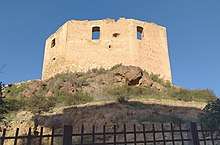 Vélez Castle.
Vélez Castle. - De la Calle Era Roman Domus: This former house has been dated in the 4th and 5th centuries AD. It was a single-family dwelling whose surface was 300 m2. It had a central courtyard and triclinium.
- Roman Salting Factory: This structure was probably made and used in the 4th and 5th centuries AD.[27]
- Vélez Castle: This fortress is located in the town centre of Mazarrón on a hillock.[28][29]
- Molinete Tower: This structure also has the name Reyes Católicos Tower (Torre de los Reyes Católicos). This is a circle-shaped lookout fortified tower which is placed on a hummock close Vélez Castle. It was built in the year 1490.[30]
- Santa Isabel Tower: This building was built in the 16th century. On one hand a reason for its settlement were the insecurity in this territory owing to Berber pirate entrances and attacks. On the other hand, this tower also enabled and facilitated fishing and agriculture activities.[31] This tower is located on a hummock in Puerto de Mazarrón. It is circle shaped in its bottom part and its body is slightly truncated circular.
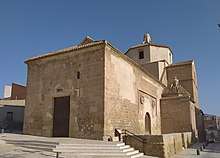 San Andrés Church
San Andrés Church - San Andrés Church: This edifice was built from 1523 to 1549, but it was remodeled in the 18th century. Its architectural style is baroc, but this church has mudéjar frames.[32]
- San Antonio de Padua Church: This church is located in the foot of the hummock where Vélez Castle is built. The building was ordered to be built by the Vélez marquis (Marqués de los Vélez) and it was finished in last 50 years of the 16th century.[33]
- De la Purísima Monastery-Church
- Ancient Alum Factory
- Mining properties of Mazarrón
- Del Arco Aqueduct: Its building date is unknown, but this aqueduct is supposed to be constructed in the 18th or 19th centuries.[34]
- Ateneo Cultural: Any document about the date of its construction has not been found, but it is known that it had been already built in the year 1844.[35]
- Towncouncil ancient building: This edifice was constructed in the last decade of the 19th century and has a modernist architectural style.[36]
- Water supply entrance in Las Salinas: This architectural structure is related to the salting activities. This building was constructed in the 20th century.[37]
- Sagrado Corazón de Jesús Sculpture: The creation of this statue was ended in the year 1924 and this sculpture was opened on May. It was crumbled during the Spanish Civil War (1936 - 1939) and restored in 1952.[38]
Sports
Probably, the most remarkable element in regards to sport in the municipality is the football team Mazarrón Fútbol Club (Mazarrón F. C.) which is in Tercera División (the fourth level of the Spanish football league system).[39]
Festivities
Purísima Concepción Festivities
This festivity is held from 4 to 8 December. It is a patron saint festivity, which is consecrated to virgin mary in regards to her Immaculate Conception. This tradition has its origins in the 18th century.[40]
During these days there are groups of people who get together specifically through out the festivities and do activities related to the celebration (the Spanish concept of 'peña'). They prepare the events that will take place during these festive days and issues related to that such as the floats of the parades.
Besides the parade, there are other activities such as the election of the queen (a tradition in Spanish traditional festivities is choosing a female child or a female young girl who will have the symbolic charge of queen during the festivities), popular games, performances from locals, graffiti exhibitions, and some popular contests such as boules contest, pet contests, tennis competitions, soccer competitions, regattas, athletics contests, etc.[40]
Festivities in the localities of Mazarrón
- El Saladillo Festivity: This festivity is held on 19 March and it is consecrated to Saint Joseph. In this festivity people in the hamlet do the festive pilmgrim called in Spain romería . Some people eat in the country roast and get together next to the patron saint statue.[41]
- Cañada de lo Gallego Festivity: Its festive days are consecrated to Saint Anthony of Padua. During this festivitiy there is a special mass and a religious parade in which people carry the patron saint statue.[42]
- La Atalaya Festivity: These festive days are consecrated to Corpus Christi. Some activities of this festivity are a mass related to the Virgin of El Rocío, soccer competitions, contests, giant paella tasting acts, etc. Cañadas del Romero Festivity: This festivity is held on 24 June and it is consecrated to John the Apostole. During this festivity there are some activities such as religious parades in which people carry the patron saint statue, a special mass, verbenas, contests, etc.
- Leiva Festivity: This festivity takes place on 16 July. During the festive days there are displays and exhibitions which are arranged by the locals.[43]
- Pastrana Festivity: This festive day takes place on 25 July and it is consecrated to James, son of Zebedee. There are some activities that are carried out by the locals during this spell such as one named 'carrera de cinta a caballo'(horse-drove and sash-wearing races)which consists (as the name indicates) in a horse-drove race in which the horsemen wear a sash and the winner gets a kiss from some lasses who play the role of ladies. People also do calva competitions, soccer matches, etc. Some performances of several kinds also take place during this day.[44][45]
- Gañuelas Festivity: Its festive day takes place on 24 August and it is consecrated to the hamlet patron saint Bartholomew the Apostole. Some activities during the festivities are verbenas, customary dance performances, fireworks performances, etc.[46]
- Majadas Festivity Despite this celebration is consecrated to Virgin Mary in her catholic facet as inmaculate, the date of the festivity takes place on the first week on September instead of its standard corresponding day on 8 December. Some activities which are carried out during these days are boules matches, soccer matches, contests of a typical Spanish dish named migas, etc. There are also music performances that also are interpreted at nights.[47]
- Las Balsicas Festivity The celebration takes place on 28 December. This festivity is named among the local 'Los Rebuznos'. The reason for this name is that the main tradition during this day consists in people making a role and their name is 'rebuznadores'. In that role these people dress up in a specific way and emit the typical sound of donkeys - the bray, whose translation in Spanish is 'rebuzno'. Hence the role 'rebuznador' which can be translated as 'people who bray', 'bray people' or 'brayers'.[48]
Notable people
- Domingo Valdivieso y Fernández-Henarejos: He was a painter related to romanticism. Valdivieso was born in the year 1830 and died in the year 1872.[49]
- José Toral y Velázquez: He became famous in his activity as a general. Toral was born in the year 1832 and died in the year 1904.[50]
- Francisco Gómez Jordana: He became famous due to his activities as a politician and to his activities as a soldier. Gómez was born in the year 1852 and died in the year 1918.[51]
External links
- Council of Mazarrón
- Mazarron.com
- Viva Murcia community info/photos from Murcia province
- A Good Morning In Spanish Video - Photo Montage of Mazarron & Bolnuevo
References
- Municipal Register of Spain 2018. National Statistics Institute.
- "Situación Geográfica" (in Spanish). Retrieved 2018-12-24.
- Instituto Nacional de Estadistica, Madrid, 2019.
- "Tower of The Horses Interpretation Center : Official Murcian Region tourist site". Retrieved 2018-12-24.
- "OISMA - LIC ES620011 Sierra de Las Moreras - Visor Contenidos" (in Spanish). 29 July 2004. Retrieved 19 December 2019.
- "Sierra de las Moreras : Official Murcia Region tourist site". Retrieved 19 December 2019.
- "HUMEDALES Y RAMBLAS (Q-3.3)" (in Spanish). Retrieved 19 December 2019.
- "Las lagunas de Las Moreras y Campotéjar: Humedales de Importancia Internacional" (in Spanish). Retrieved 2020-06-09.
- "Murcianatural - Humedal de Importancia Internacional Las Moreras" (in Spanish). 2019-06-19. Retrieved 2020-06-09.
- "Pedanías" (in Spanish). Retrieved 2018-12-25.
- "INEbase / Demography and population /Municipal Register. Population by municipality /Nomenclature: Continuous Register Population by Population Unit / Results". www.ine.es. Retrieved 2018-12-25.
- "Historia de Mazarrón - Prehistoria - Región de Murcia Digital" (in Spanish). Retrieved 2018-12-26.
- "Cabezo del Plomo-Descripción - Región de Murcia Digital" (in Spanish). Retrieved 2019-01-31.
- "Historia de Mazarrón - Antigüedad - Región de Murcia Digital" (in Spanish). Retrieved 2018-12-26.
- "Historia de Mazarrón - Edad Moderna - Región de Murcia Digital" (in Spanish). Retrieved 2018-12-26.
- "Historia de Mazarrón - Edad Contemporánea - Región de Murcia Digital" (in Spanish). Retrieved 2018-12-26.
- "Estado actual del mercado inmobiliario. Informe 2012 Mazarrón" (in Spanish). p. 9. Retrieved 2020-02-02.
- "Cifras de empleo municipal. Segundo semestre de 2013. Municipio de Mazarrón". pp. 12, 18. Retrieved 2020-02-02.
- "Bahía de Mazarrón. Esencia del Mediterráneo. Web Oficial de Turismo de Mazarrón" (in Spanish). Retrieved 2018-12-27.
- "Bahía de Mazarón. Esencia del Mediterráneo. Web Oficial de Turismo de Mazarrón" (in Spanish). Retrieved 2018-12-27.
- "Bahía de Mazarrón. Esencia del Mediterráneo. Web Oficial de Turismo de Mazarrón" (in Spanish). Retrieved 2018-12-27.
- "Cabezo del Plomo : Official Murcia Region tourist site". murciaturistica.es. Retrieved 2019-01-20.
- "Punta de los Gavilanes (sparrowhawk Point) : Official Murcia Region tourist site". murciaturistica.es. Retrieved 2018-12-27.
- "Phoenician Boat Interpretation Center : Official Murcia Region tourist site". murciaturistica.es. Retrieved 2018-12-27.
- "Villa del Alamillo - Región de Murcia Digital" (in Spanish). Retrieved 2018-12-27.
- "The Roman Milestone : Official Murcia Region tourist site". murciaturistica.es. Retrieved 2018-12-27.
- "Archaeological Museum And Roman Salting Factory : Official Murcia Region tourist site". murciaturistica.es. Retrieved 2019-01-20.
- "Castillo de los Vélez : Official Murcia Region tourist site". murciaturistica.es. Retrieved 2019-01-20.
- "Castillo de los Vélez de Mazarrón - Región de Murcia Digital" (in Spanish). Retrieved 2019-01-10.
- "The Molinete Tower : Official Murcia Region tourist site". murciaturistica.es. Retrieved 2019-01-20.
- "Tower Of Santa Isabel : Official Murcia Region tourist site". murciaturistica.es. Retrieved 2018-12-27.
- "Iglesia de San Andrés de Mazarrón - Región de Murcia Digital" (in Spanish). Retrieved 2018-12-27.
- "San Antonio de Padua Church : Official Murcia Region tourist site". murciaturistica.es. Retrieved 2018-12-27.
- "The Arco Aqueduct : Official Murcia Region tourist site". murciaturistica.es. Retrieved 2019-01-20.
- "Ateneo Cultural - Región de Murcia Digital" (in Spanish). Retrieved 2018-12-27.
- "Casas Consistoriales (old Town Hall) : Official Murcia Region tourist site". murciaturistica.es. Retrieved 2019-01-20.
- "las Salinas Water Supply Entrance (pim-pam) : Official Murcia Region tourist site". murciaturistica.es. Retrieved 2019-01-20.
- "Sacred Heart Of Jesus Of Mazarrón". Official Murcia Region tourist site. Retrieved 2018-12-27.
- "EL MAZARRÓN F.C. LUCE SUS TROFEOS Y FOTOGRAFÍAS DE SUS EQUIPOS EN UNA NUEVA SALA EXPOSITIVA" (in Spanish). Retrieved 2020-01-31.
- "Fiestas de la Purísima Concepción - Región de Murcia Digital" (in Spanish). Retrieved 2018-12-30.
- "El Saladillo - Fiestas Locales - Región de Murcia Digital" (in Spanish). Retrieved 2018-12-30.
- "Cañada de Lo Gallego - Región de Murcia Digital" (in Spanish). Retrieved 2018-12-30.
- "Leiva - Región de Murcia Digital" (in Spanish). Retrieved 2018-12-30.
- "Ifre-Pastrana - Región de Murcia Digital" (in Spanish). Retrieved 2018-12-30.
- "Carrera de cintas a caballo - Región de Murcia Digital" (in Spanish). Retrieved 7 February 2019.
- "Gañuelas - Región de Murcia Digital" (in Spanish). Retrieved 2018-12-30.
- "La Majada - Fiestas Locales - Región de Murcia Digital" (in Spanish). Retrieved 2019-02-05.
- "Balsicas - Región de Murcia Digital" (in Spanish). Retrieved 2019-02-05.
- "Domingo Valdivieso y Henarejos- Biografía - Región de Murcia Digital" (in Spanish). Retrieved 2018-12-30.
- "José Toral y Velázquez - Región de Murcia Digital" (in Spanish). Retrieved 2018-12-30.
- "Francisco Gómez Jordana - Región de Murcia Digital" (in Spanish). Retrieved 2018-12-30.